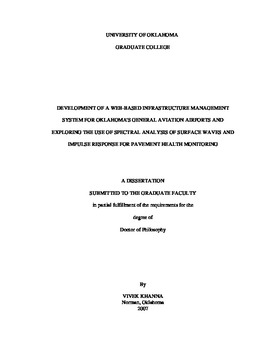| dc.contributor.advisor | Miller, Gerald A., | en_US |
| dc.contributor.advisor | Mooney, Michael A., | en_US |
| dc.contributor.author | Khanna, Vivek. | en_US |
| dc.date.accessioned | 2013-08-16T12:20:38Z | |
| dc.date.available | 2013-08-16T12:20:38Z | |
| dc.date.issued | 2007 | en_US |
| dc.identifier.uri | https://hdl.handle.net/11244/1185 | |
| dc.description.abstract | The transportation infrastructure of the United States consumes over 17% of its Gross National product annually and is currently valued at $1.75 trillion. With the interstate system now 50 years old, the emphasis of the transportation community has shifted from building new assets to maintaining and improving existing assets. Total Expenditures on highways and bridges remain at record levels - $147.5 billion in 2004. | en_US |
| dc.description.abstract | FHWA advocates the use of transportation asset management rationale in addressing pavement needs and improving customer satisfaction. Transportation asset management is not merely a Pavement Management (PMS) software, it is a decision making process that helps network administrators efficiently allocate limited resources for maximum benefit. The Oklahoma Aeronautics Commission (OAC) felt the need for such a system to efficiently allocate scarce resources at Oklahoma's General Aviation airports. | en_US |
| dc.description.abstract | OAC teamed up with the University of Oklahoma's school of civil engineering and environmental science (CEES); the effort resulted in a web-based infrastructure management system (IMS). A far-cry from the previous ''squeaky wheel'' system, OAC's web-based IMS presents a vast storehouse of information---visual distresses, PCI ratings, results of nondestructive tests, geotechnical information, to stakeholders. CEES also felt the need to advance the existing PCI based PMS in use at the time. Accordingly, the Spectral Analysis of Surface Waves (SASW) method and the Impulse Response (IR) method were identified as potential tools for pavement health monitoring. The efficacy of these non-destructive test methods was rigorously investigated. SASW was found to be a potentially valuable tool to characterize pavement sections without core extractions. Low strain moduli for pavements with asphalt and portland cement concete surfaces estimated from SASW tests were observed to degrade with time and regression models for this deterioration were prepared and are presented. The ease of testing with the IR method and quick data analysis presents an opportunity for greater spatial coverage of pavements thereby providing a complete picture of the tested site to engineers. It was observed that the pavement section's dynamic stiffness estimated from IR tests degrades with age and regression models capturing this deterioration were prepared. | en_US |
| dc.format.extent | xii, 193 leaves : | en_US |
| dc.subject | Pavements Maintenance and repair. | en_US |
| dc.subject | Engineering, Civil. | en_US |
| dc.subject | Pavements Performance. | en_US |
| dc.subject | Runways (Aeronautics) Maintenance and repair. | en_US |
| dc.title | Development of a Web-based infrastructure management system for Oklahoma's general aviation airports, and, Exploring the use of spectral analysis of surface waves and impulse response for pavement health monitoring. | en_US |
| dc.type | Thesis | en_US |
| dc.thesis.degree | Ph.D. | en_US |
| dc.thesis.degreeDiscipline | School of Civil Engineering and Environmental Science | en_US |
| dc.note | Source: Dissertation Abstracts International, Volume: 68-04, Section: B, page: 2518. | en_US |
| dc.note | Advisers: Gerald A. Miller; Michael A. Mooney. | en_US |
| ou.identifier | (UMI)AAI3261108 | en_US |
| ou.group | College of Engineering::School of Civil Engineering and Environmental Science | |
